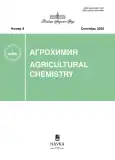Herbicide Milagro Plus for Corn Protection against Weeds
- Autores: Bagrintseva V.N.1, Guba E.I.1, Kuznetsova S.V.1
-
Afiliações:
- All-Russian Research Institute of Corn
- Edição: Nº 9 (2025)
- Páginas: 67-74
- Seção: Пестициды
- URL: https://bakhtiniada.ru/0002-1881/article/view/319000
- DOI: https://doi.org/10.7868/S3034496425090081
- ID: 319000
Citar
Resumo
In a field experiment conducted in 2022–2024 at the All-Russian Research Institute of Corn in the Stavropol Territory, the effectiveness and phytotoxic effect of the post-emergence herbicide Milagro Plus, MD on hybrids and corn lines was studied. Experimental options: 1 – control without herbicides, 2 – Milagro Plus (1.0 l/ha). The high sensitivity of weeds to the active ingredients of the drug has been established. 21 days after application, 77.0% of weeds died from the action of the Milagro Plus herbicide over an average of 3 years. The decrease in the number of dicotyledonous weeds was 68.6%, monocotyledonous – 88.6%, with a decrease in the above-ground mass by 75.5 and 94.1%. By the end of the growing season, corn control without chemical weed killing was heavily clogged, with an average of 42.3 plants growing per 1 m2 in 2022–2024 weeds weighing 960 g/m2. In the Milagro Plus herbicide experiment, weed death was 75.4%. The decrease in the number of dicotyledonous plants over an average of 3 years was 76.6%, monocotyledonous – 73.2%. The total vegetative mass of weeds decreased by 92.3% compared to the control, the mass of dicotyledonous weeds decreased by 93.1%, and monocotyledonous weeds decreased by 86.5%. The response of hybrids and lines to the use of the herbicide over the years of the study was mixed. In 2022, lightening of the upper leaves or their bases was noted in the Mashuk 140 hybrid, the maternal form of Alpha M and 4 lines (CL 6M, RD 2144, RG 298 MV, RM 146). In 2023, a greater number of studied hybrids and maize lines showed lightening of the base of the upper leaves, whereas in 2024. No signs of the herbicide’s effects on corn plants have been recorded.
Sobre autores
V. Bagrintseva
All-Russian Research Institute of Corn
Email: maize-techno@mail.ru
Pyatigorsk, ul. Yermolova 14o, Russia
E. Guba
All-Russian Research Institute of Corn
Email: maize-techno@mail.ru
Pyatigorsk, ul. Yermolova 14o, Russia
S. Kuznetsova
All-Russian Research Institute of Corn
Autor responsável pela correspondência
Email: maize-techno@mail.ru
Pyatigorsk, ul. Yermolova 14o, Russia
Bibliografia
- Панфилов А.Э. Сценарный подход к контролю засоренности кукурузы в лесостепи Зауралья // Вестн. Челябинск. Гос. агроинж. акад. 2014. Т. 70. С. 198–204.
- Зезин Н.Н., Скутина Л.С., Панфилов А.Э., Казакова Н.И. Зональные особенности применения гербицидов кросс-спектра в посевах кукурузы на Южном и Среднем Урале // Кормопроизводство. 2017. № 6. С. 22–26.
- Проворова О.Н., Панасин В.И., Григорович Л.М. Агрохимические аспекты эффективности применения гербицидов класса сульфонилмочевин при выращивании кукурузы (Zea mays L.) на зерно // Пробл. агрохим. и экол. 2018. № 1. С. 24–28.
- Костюк А.В., Лукачева Н.Г. Эффективность гербицида Дублон Голд на кукурузе в Приморье // Земледелие. 2014. № 1. С. 46–48.
- Кузнецова С.В., Багринцева В.Н. Отечественные гербициды для защиты кукурузы от сорняков // Земледелие. 2021. № 4. С. 44–46.
- Савва А.П., Тележенко Т.Н., Ковалев С.С., Суворова В.А. Отечественный комбинированный гербицид Суперкорн, МД для защиты посевов кукурузы // Земледелие. 2021. № 4. С. 40–43.
- Прудников А.Д., Солнцева О.И. Применение гербицидов при возделывании раннеспелых гибридов кукурузы // Защита и карантин раст. 2019. № 8. С. 46–48.
- Тедеева А.А. Применение гербицидов нового поколения при возделывании кукурузы в предгорной зоне РСО – Алания // Научн. жизнь. 2020. Т. 15. № 7 (107). С. 924–931.
- Спиридонов Ю.Я., Жемчужин С.Г. Современное состояние проблемы изучения применения гербицидов (Обзор публикаций за 2011–2013 гг.) // Агрохимия. 2016. № 5. С. 76–85.
- Губа Е.И., Багринцева В.Н., Кузнецова С.В. Гербициды Крейцер и Аденго на гибридах и линиях кукурузы // Защита и карантин раст. 2022. № 9. С. 15–19.
Arquivos suplementares









